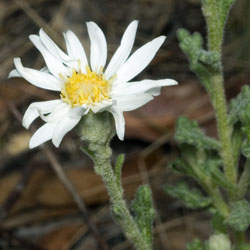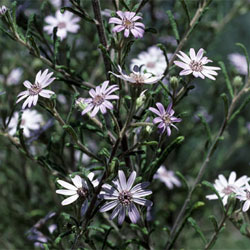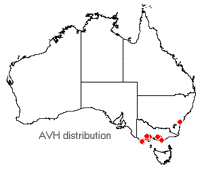Olearia asterotricha
Rough Daisy-bush
Olearia asterotricha (F.Muell.) Benth.
Olearia asterotricha belongs to the family Asteraceae, also called the daisy family, which is the largest family of flowering plants. The genus Olearia consists of about 180 species restricted to the southern hemisphere including 130 species endemic to Australia. The genus is distinguished easily by woody stem and branches. Hence it is called Daisy Bushes.
O. asterotricha is small attractive shrub, 1-2 m high and 1.5-2 m wide. Branches are spreading or arching. The shrub bears many flowers which vary in colours from mauve to blue or white with yellow centre. Flower heads are 2 to 4 cm in diameter, with 15 to 21 ray florets, often solitary or in small clusters. Achenes are silky-hairy. The leaves are 0.6 to 2.5 cm long and 0.2 to 0.8 cm wide, deep green with starry hairs on the upper surface and paler green and felty underneath with toothed or entire margins.
O. asterotricha is found from Blue Mountains to western Victoria. Its habitat is generally cool moist soils of health or dry sclerophyll forest and extends from coast area to inland and even in mountains.
Different characteristics seem to occur in two geographically divided regions. O. asterotricha in the Sydney region is quite compact and has white flowers and gray green leaves whereas the Victorian form has more open growth, with mauve-blue flowers and green leaves.
O. asterotricha flowers from October to July. As it bears many attractive flowers which can last for a month, the shrub is good for mass displays. O. asterotricha propagates from cuttings well. Choose young cuttings with plenty of healthy nodes as slugs, snails or caterpillar larvae may damage the nodes. Low concentration (1-2g/L) of rooting hormone helps development of roots and using sterilised media is crucial to minimise fungal attack. Rooting media composed of 5 perlite: 1 coir fibre is effective for root growth. To maximise healthy root growth, apply a light mist so that stems do not dry out and keep space between individuals for good air movement because hairy plants are susceptible to fungal attack. Roots develop in 4-6 weeks. When roots are established, the plant can be placed to drier environment.
Propagation from seeds is more challenging than from cuttings. Better seed germination is expected after seed are heated from the bottom at 22 C° in humid conditions.
The shrub prefers cool, well-drained, moist acidic soil. It is also best in protected, sunny or semi-shaded place. Combination with taller shrubs, such as Fuschia species, helps to create a suitable environment for O. asterotricha. It tolerates moderate frosts and short dry periods.
As too much moisture in soil can causes the fungus problem, water plants from the pot plates if you grow them in pots. O. asterotricha has no specific nutrition issue and a standard fertiliser is appropriate. Stem borers can cause regular problems for woody branches. Collar rot can occur if too much mulch is placed around the trunk or stems of plants. Slugs, snail and caterpillars can damage young plants.
To produce a compact form, plants can be pruned when they are young. This results in plants of bushier habit.
Text by Naeko Omomo (2011 Student Botanical Intern)
Name Meaning: Olearia asterotrichaOlearia – named in honour of German botanist, J.G.Oelschlaeger (1635-1711) [Latinised as Olearius] asterotricha – ‘starry hair’ in Latin, referring to numerous star shaped hairs on leaves and stems. |
References
Australian Daisy Study Group ( 1987 ) Australian Daisies for garden and floral art . Lothian, Melbourne.
Elliot, W .R. and Jones, D. L. ( 1997 ) Encyclopedia of Australian plants suitable for cultivation , vol. 7. Thomas C. L o thian, Melbourne.
Harden, G. J. (ed . ) ( 2002 ) Flora of New South Wales, vol. 3. University of New South Wales , Sydney.
Harris, T.Y. ( 1977 ) Gardening with Australian Plants shrubs , Thomas Nelson, M elbourne .
Johnson, K.A. and Burchett, M. (eds.) (1996) Native Australian Plants horticulture and uses, University of New South Wales, Sydney.
Payne, H. W. ( 1978-1980 ) Australian Plants, vol. 10 & 11, iss. 73-84, Society for Growing Australian Plants.
P. Carmen (2011) Horticulturist, Australian National Botanic Gardens. Pers. comm.
Website: PlantNET - NSW Flora Online: http://plantnet.rbgsyd.nsw.gov.au/cgi-bin/NSWfl.pl?page=nswfl&lvl=sp&name=Olearia~asterotricha
![An Australian Government Initiative [logo]](/images/austgovt_brown_90px.gif)




